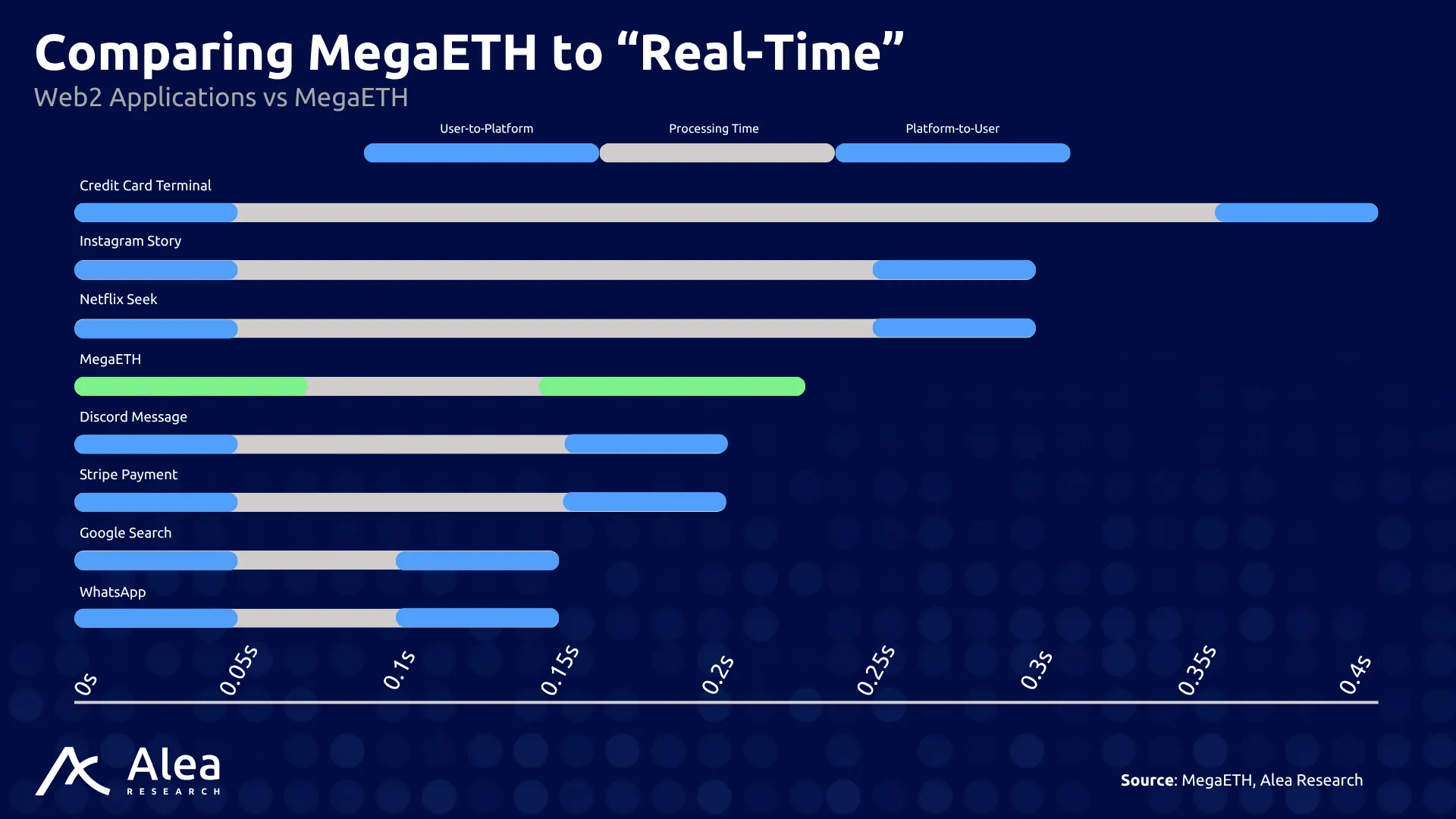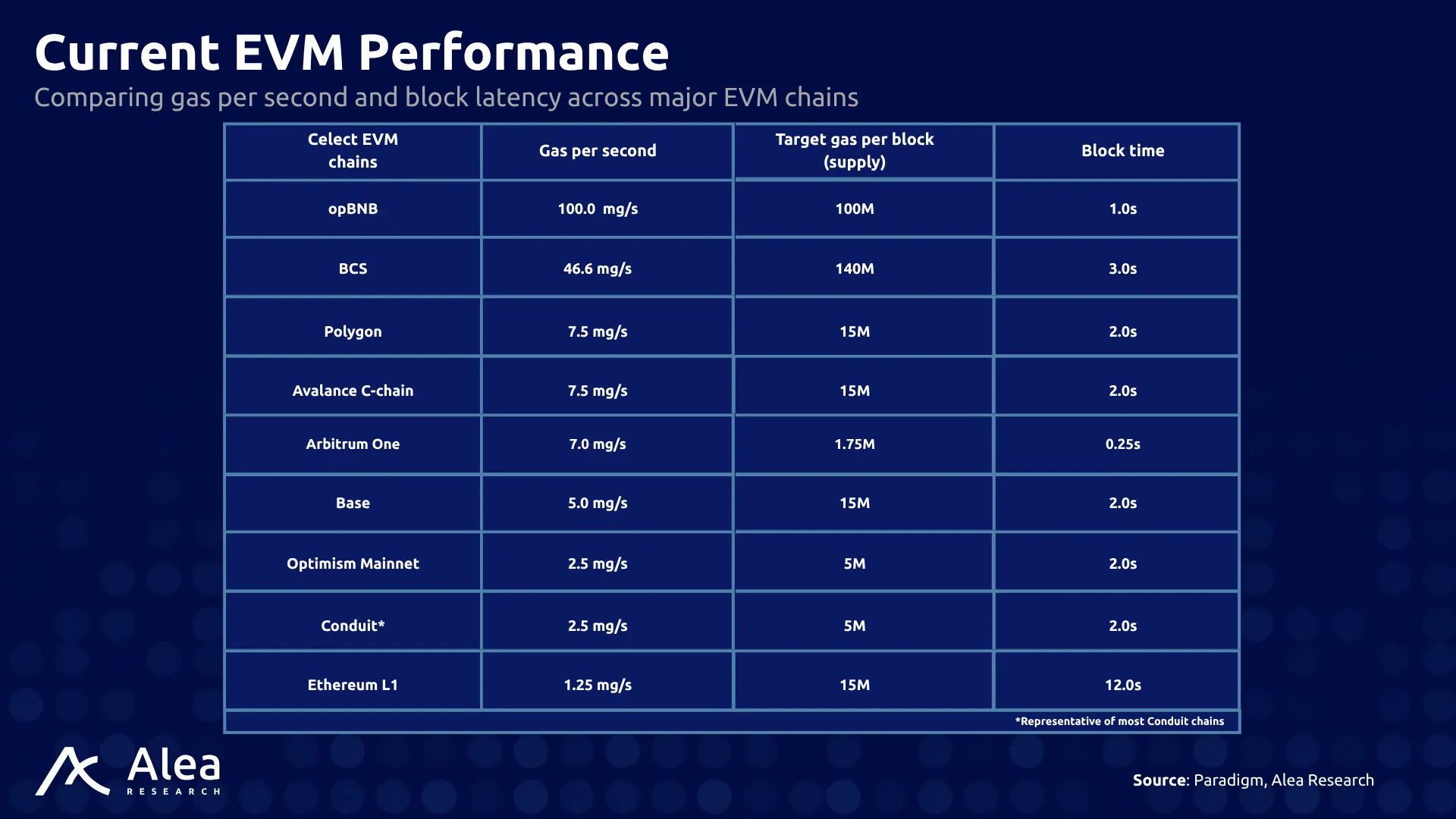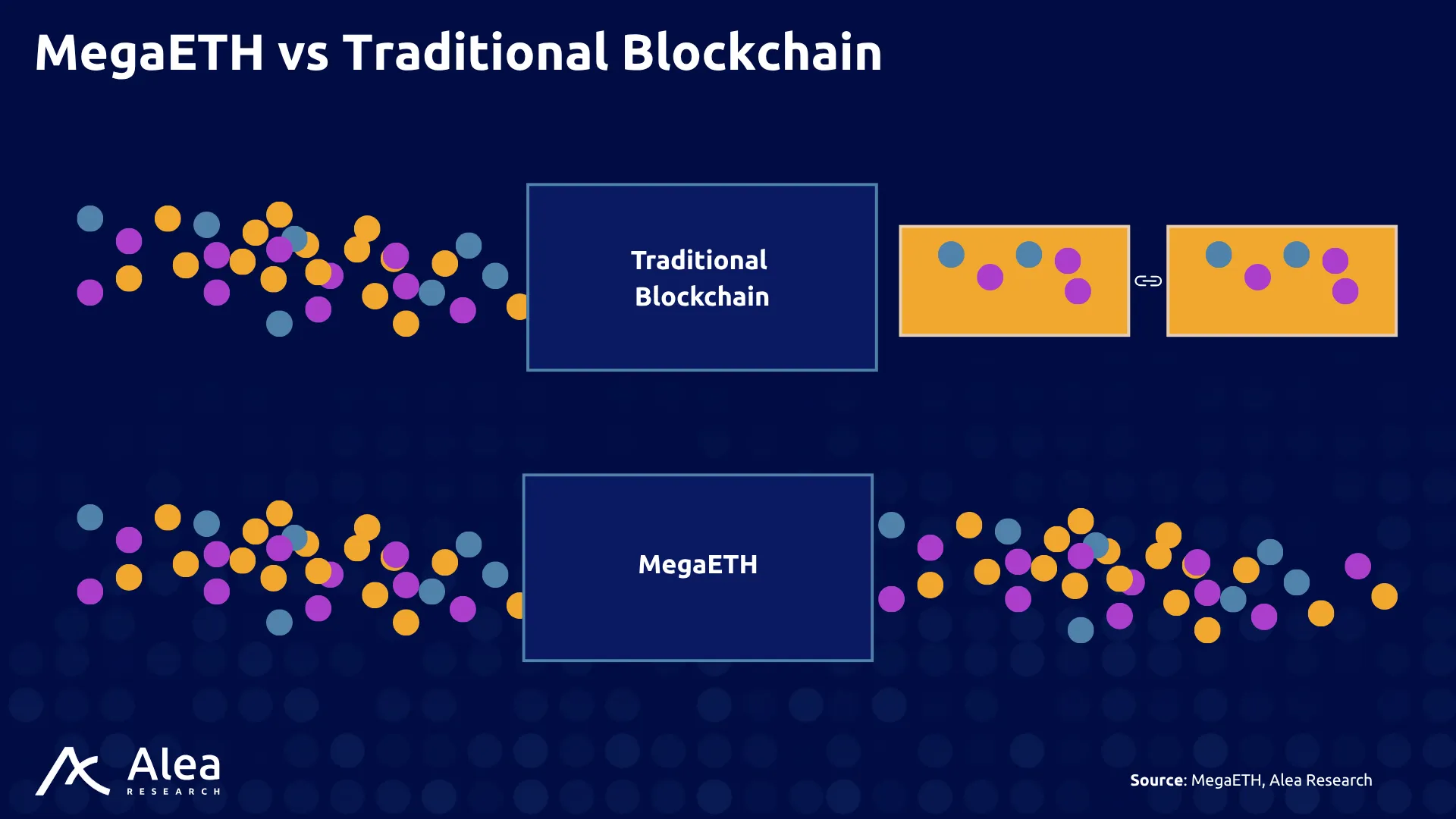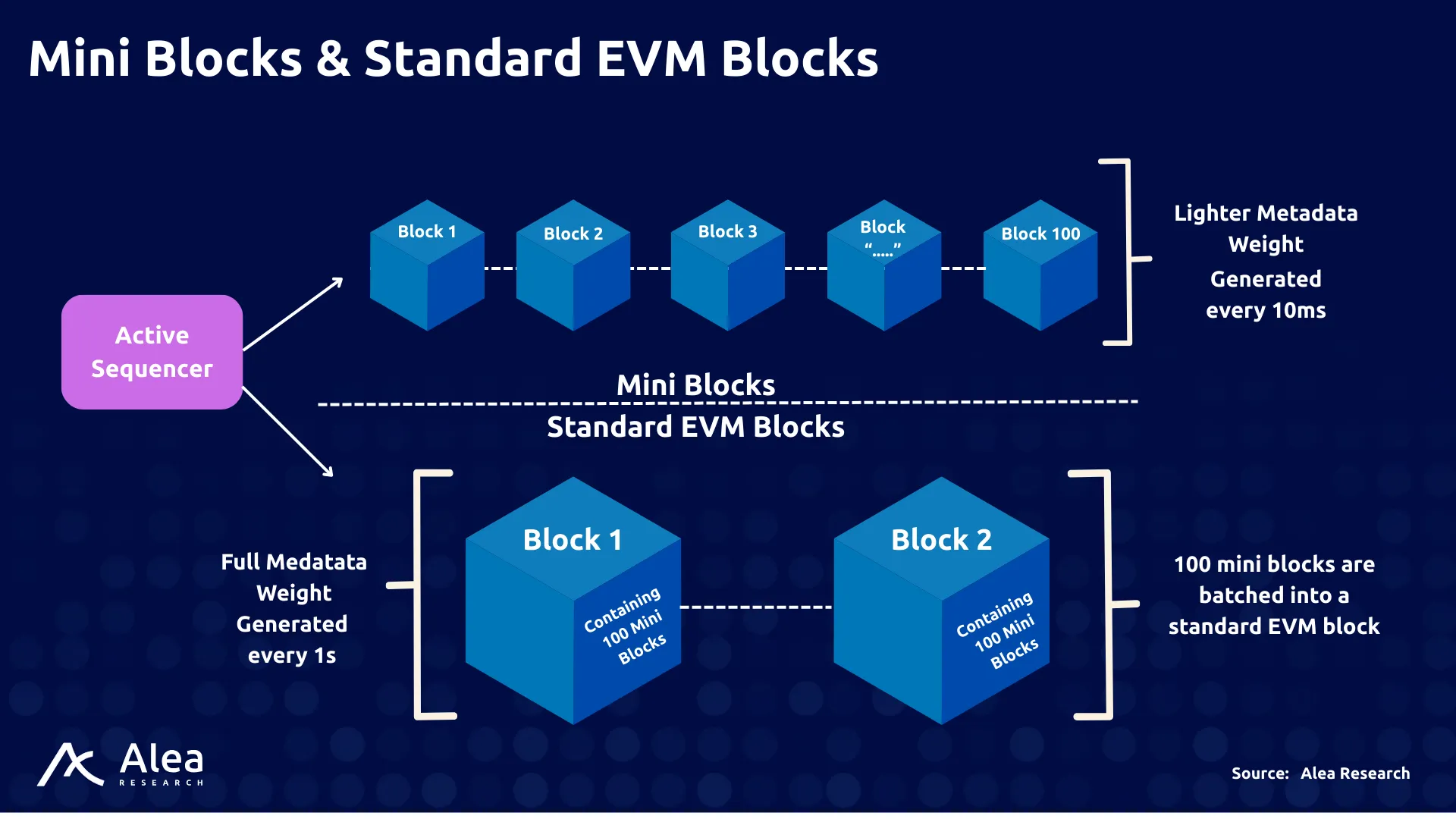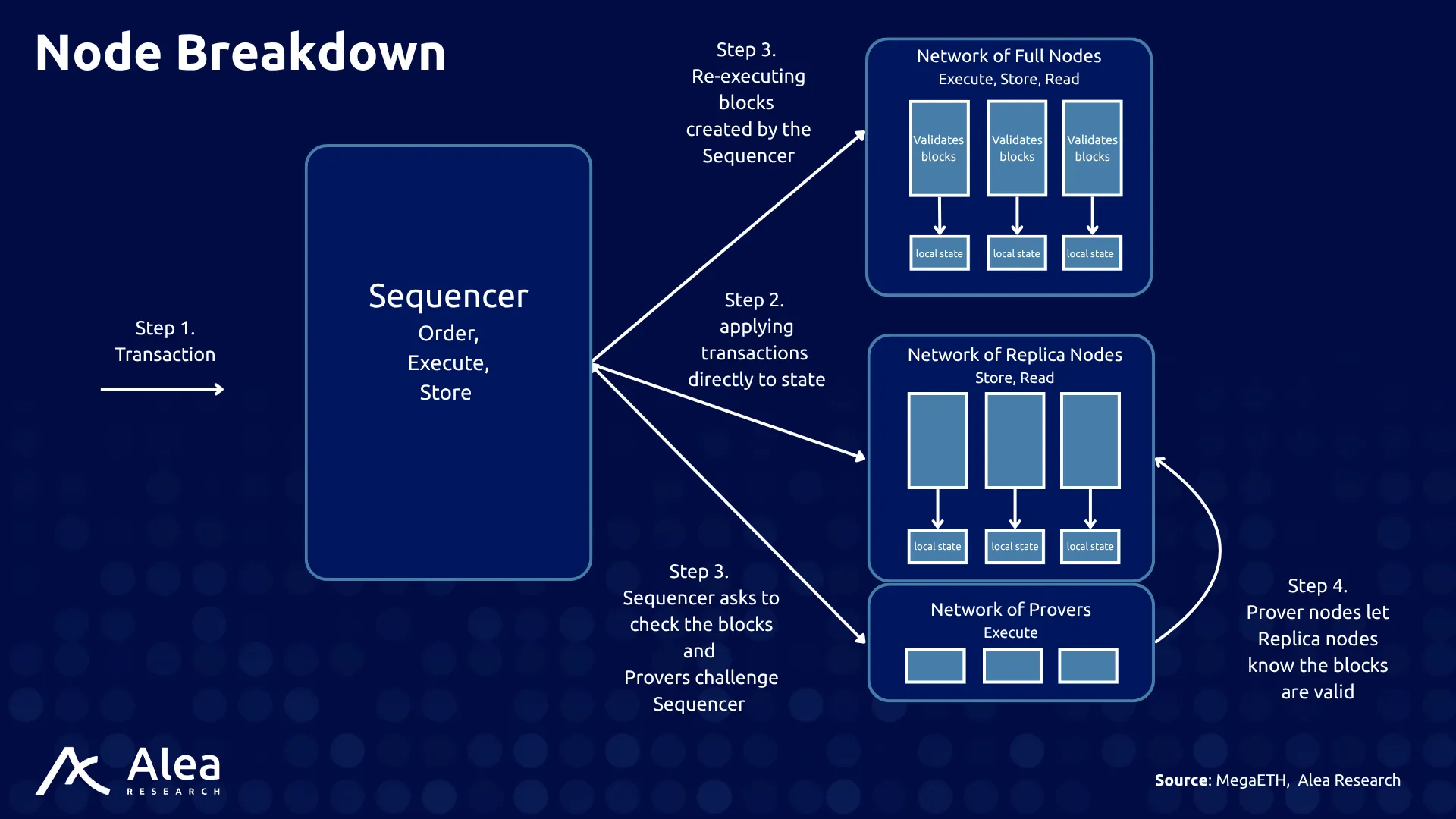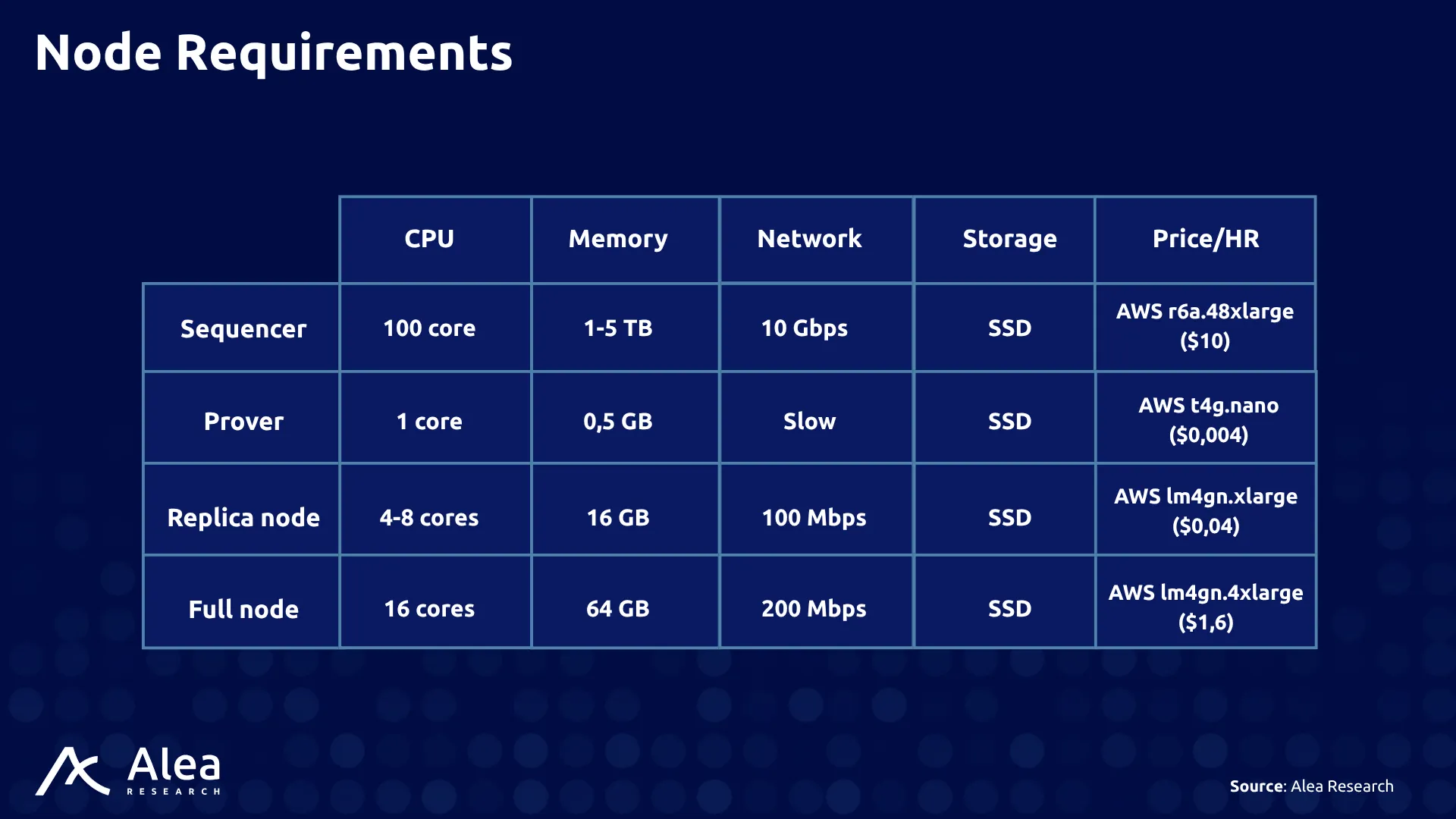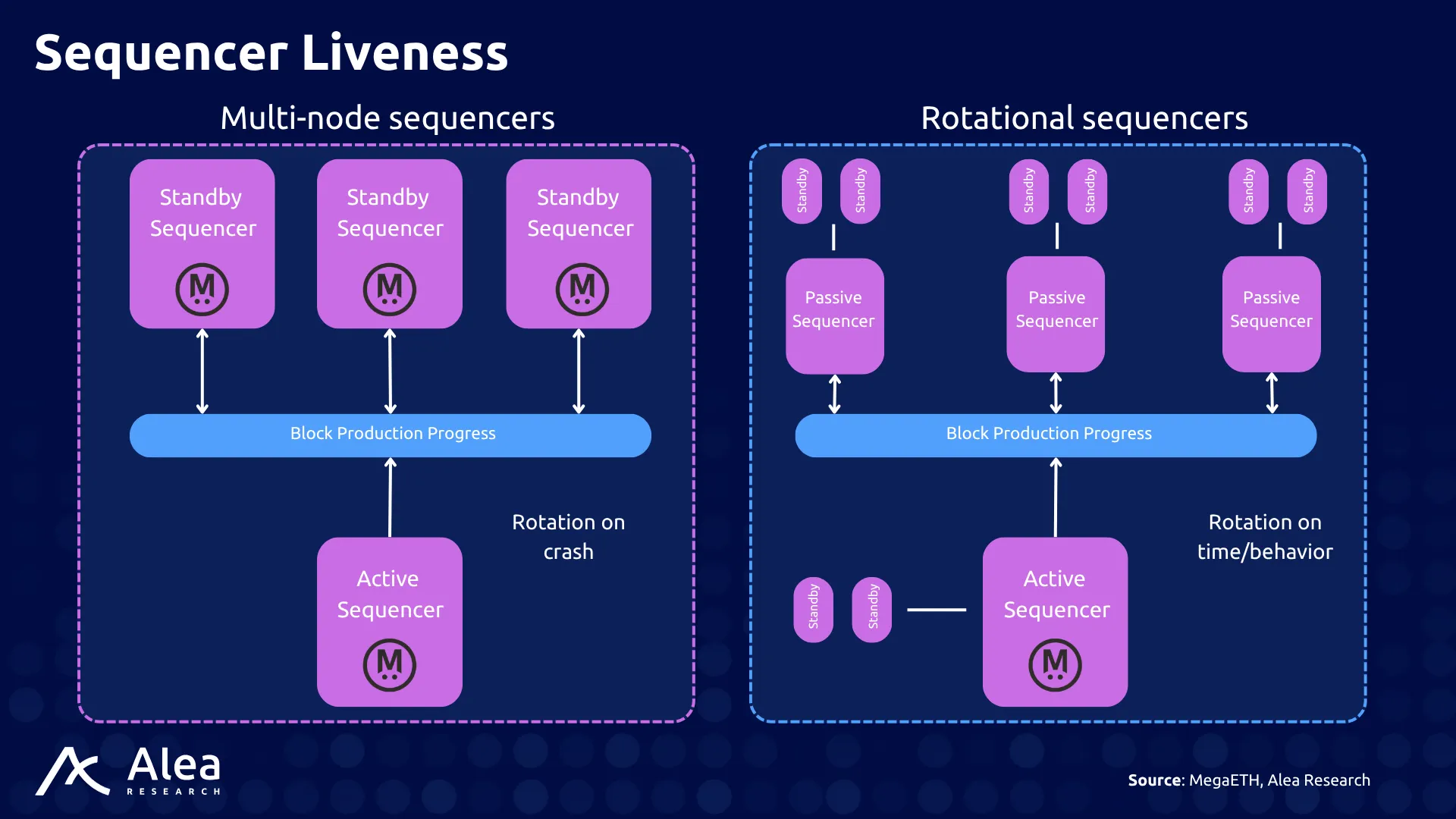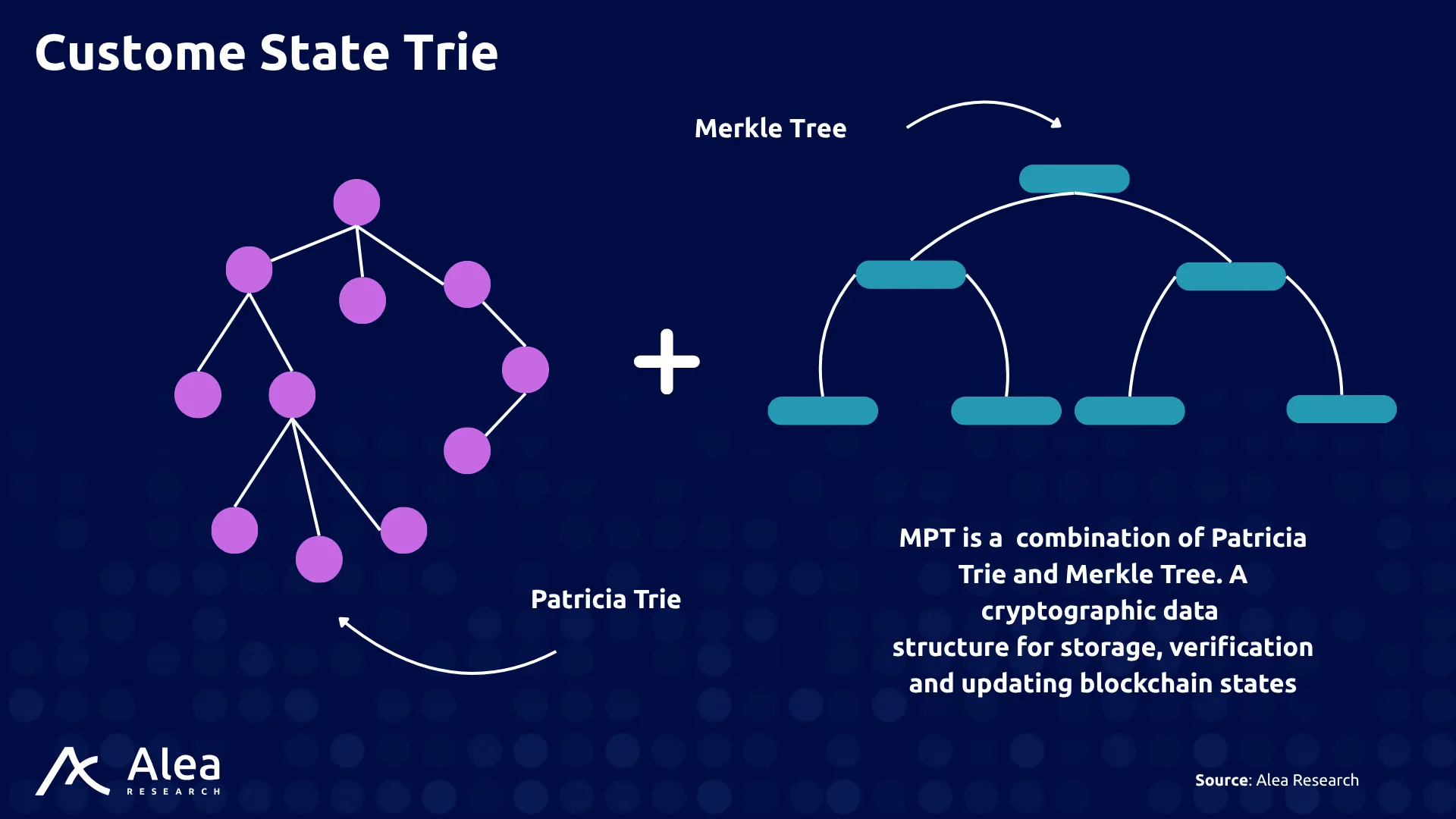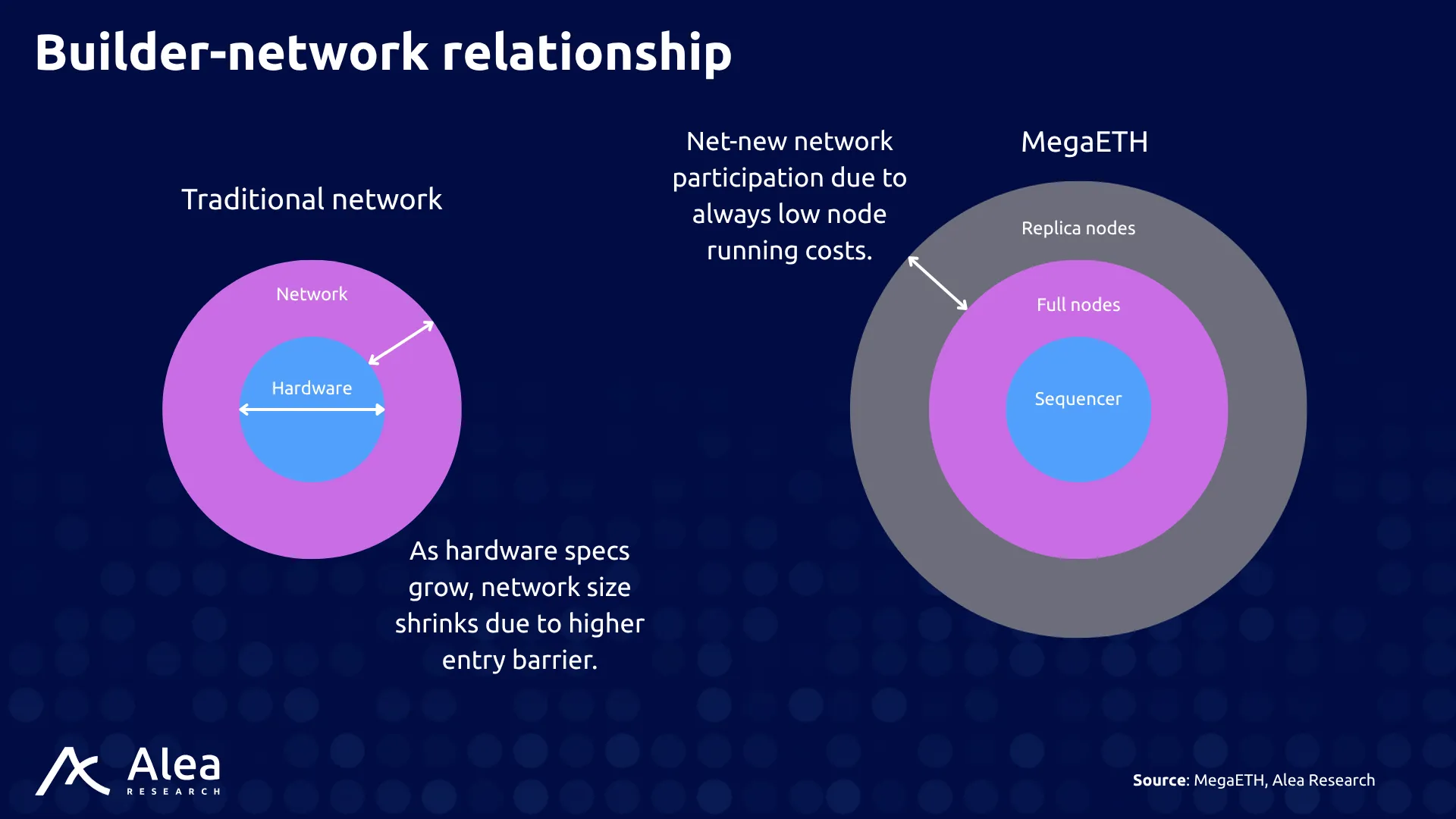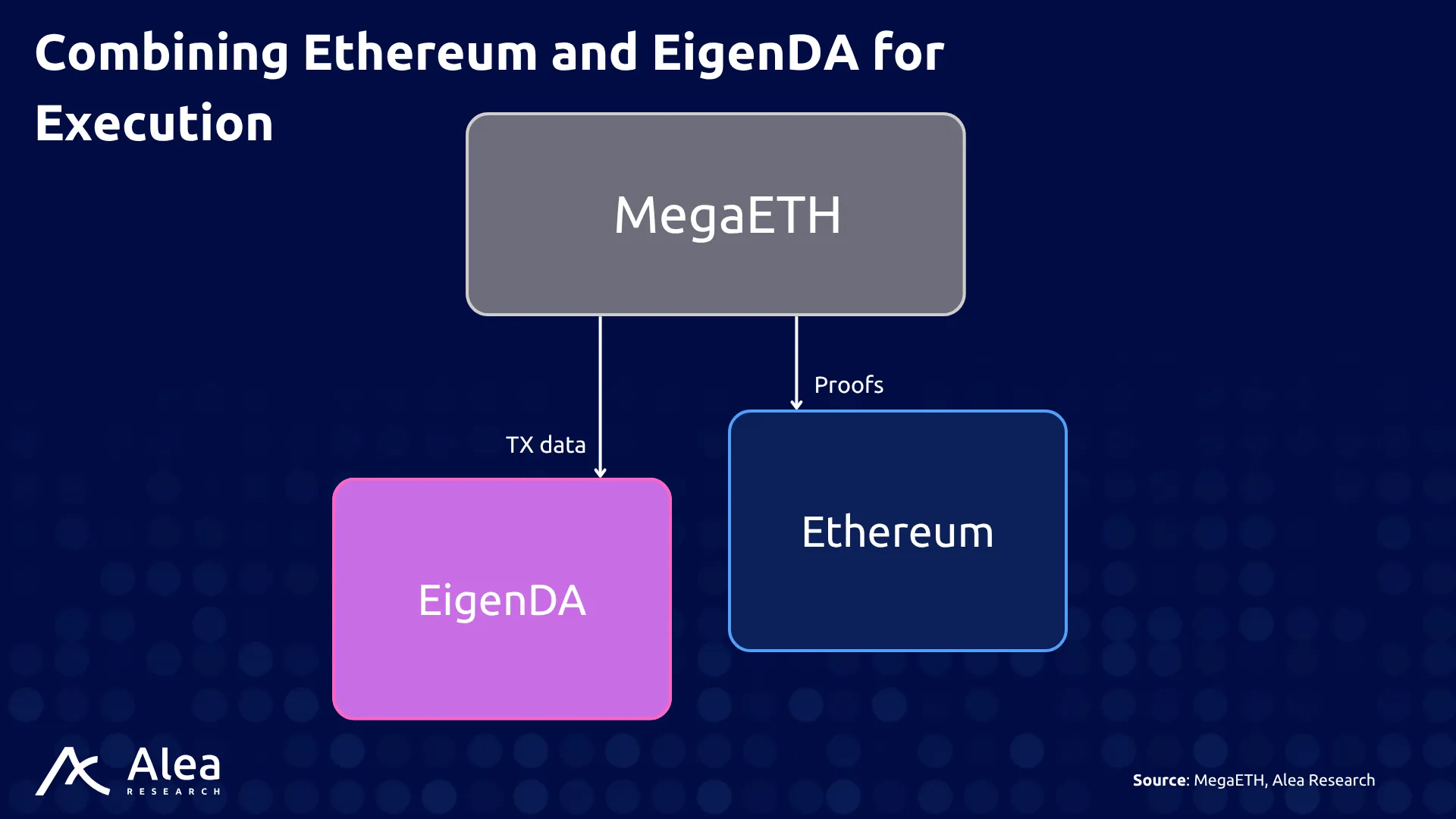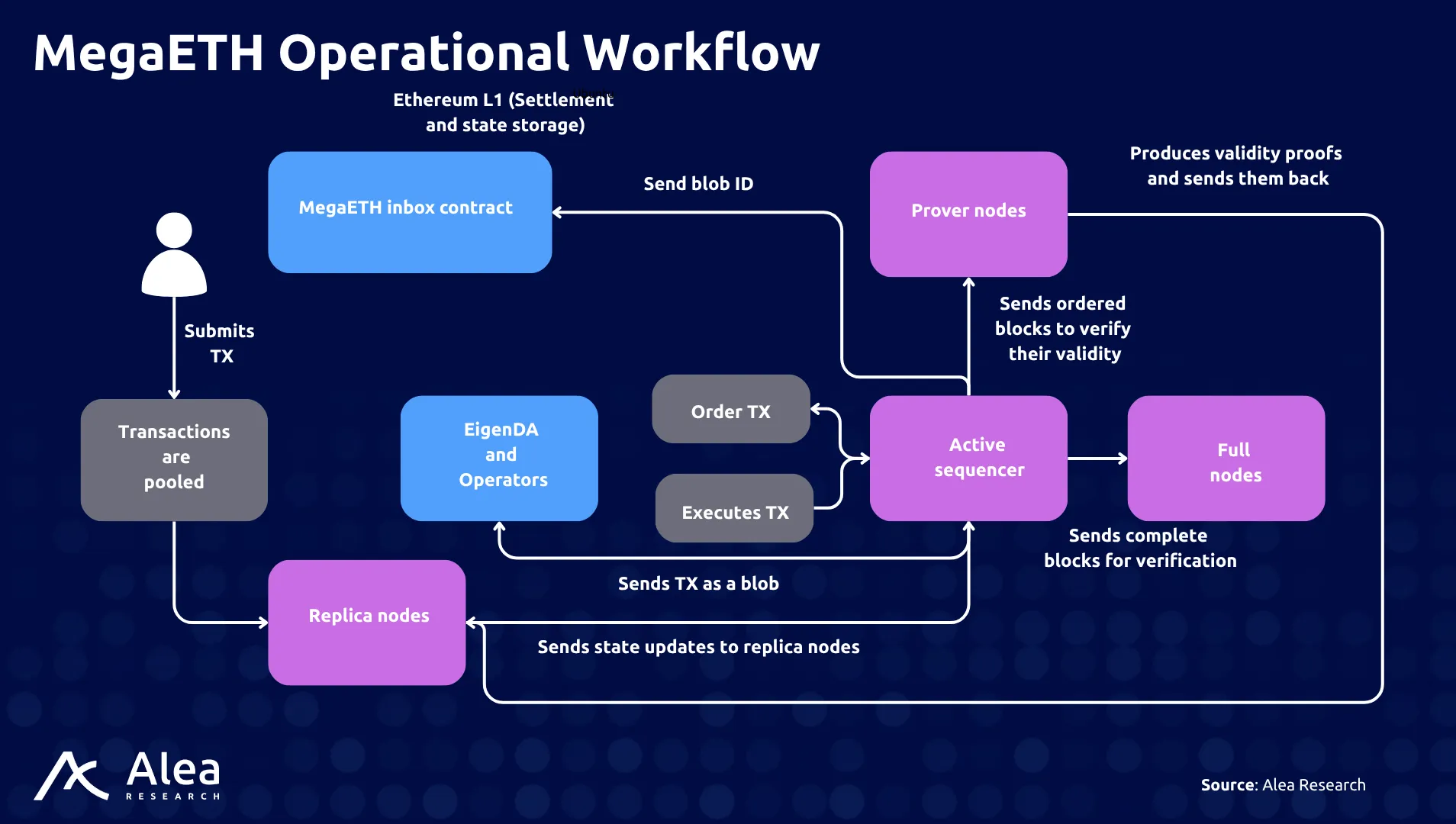Overview
MegaETH is an EVM-compatible blockchain and a L2 scaling solution for Ethereum targeting real-time performance. It is designed to deliver low-latency and high transaction throughput up to 100k transactions per second (TPS) with consistent millisecond response times.
MegaETH is targeting developers, users, and institutions looking for real-time infrastructure. The design embraces performance-first trade-offs with an architecture that consists of specialized nodes for different functions. Block production is centralized through a single high-performance sequencer node that executes and orders all transactions, while relying on decentralized validation layers to ensure trustlessness and correctness. Features such as in-memory EVM state, JIT compilation, and a custom state trie further enable throughput without compromising Ethereum security. MegaETH seeks to compete not just with other high-performance blockchains but also with Web2 applications and systems.
Problem Statement
MegaETH aims to bridge the gap between blockchain capabilities and traditional cloud computing performance, allowing for applications that demand speed and ultra-fast execution. The Ethereum Virtual Machine (EVM) faces significant scalability challenges that have become increasingly prominent as blockchain adoption grows, yet it remains the most adopted and mature environment for blockchain development, and with the strongest network effects among developers. Solving the performance bottleneck would let the most adopted and battle-tested stack finally meet mainstream consumer expectations for speed and reliability. It’s not just the EVM; other blockchains also have scalability limitations and performance tradeoffs that hinder the potential for global adoption and restrict developers from building complex, high-demand applications.
Current EVM chains (both L1s and L2s) cannot support dApps that require <100ms update frequencies, such as high-frequency trading or real-time gaming. For MegaETH, the primary design goal is to deliver Web2-level responsiveness (millisecond confirmation, 100k+ tps) while retaining Ethereum’s credible neutrality and trust guarantees. The objective is to answer the problem, “How can an EVM chain push performance to hardware limits without sacrificing Ethereum-level trust and security?”
Existing EVM chains face a series of bottlenecks that most of them have in common:
- Sequential execution: The spec assumes strictly ordered transactions, and latency is dominated by the slowest dependency chain.
- Inefficient state root updates: This is a computationally expensive problem. Even in Reth (the fastest execution client), state root IO dominates compute and is ~10x more expensive than executing transactions.
- State sync bandwidth: Full nodes must download the entire modified storage slots instead of just a receipt.
- Block gas limits: Even if engines speed up, the maximum speed achievable by a chain is limited by its block gas limit, which is baked into consensus.
To remove the hardware-driven ceilings that the EVM didn’t optimize for, MegaETH assumes a series of tradeoffs to provide the real-time guarantees that builders demand for coming up with applications that wouldn’t be feasible in other environments. The ideal outcome is to achieve Web2-class latency while keeping end-user trust assumptions identical to other rollups.
The core problem is to push hardware performance to the limit, handling tens of thousands of transactions per second and confirmation in tens of milliseconds while retaining the trust guarantees of Ethereum settlement. Traditional rollups attack only the data-availability side; monolithic high-performance L1s drop EVM compatibility; parallel-EVM L1s add some concurrency but keep consensus and state sync in the way. MegaETH argues that none of these paths removes the real bottlenecks: strictly sequential execution, slow state-root updates, bandwidth-heavy node sync, and conservative block-gas ceilings.
Today, most rollups still inherit the same serial execution bottlenecks of the L1 EVM implementation. With L2s, there are two dominant designs: optimistic and ZK rollups. The former imposes week-long withdrawal delays while the latter is often not EVM-equivalent and introduces complexities for developers. At the same time, interpreter execution and state updates still have a heavy CPU and IO tax. Updating the state root touches dozens of random DB pages, forcing low block-gas limits and driving blob or calldata fees high even after EIP-4844. Because most onchain applications inherit Ethereum’s single-threaded interpreter, Merkle-trie I/O (input/output), and tight gas limits, latency-sensitive experiences (real-time games, onchain order books, AI inference markets) remain out of reach. MegaETH sets out to close that gap without leaving Ethereum’s security umbrella.
MegaETH unlocks parallel execution and breaks the ceilings of existing rollups with a two-stage pipeline and node specialization; it outsources heavy compute to one high‑end machine while cheap replica nodes preserve decentralized validation. A single, over-provisioned sequencer keeps the full state in memory and runs a parallel engine that enables milliseconds transaction response with blocks every ~10ms.
Thus, MegaETH re-architects the entire stack around a specialized sequencer that keeps the full state in memory and runs a hyper-optimized parallel EVM engine. Replica nodes receive compressed state diffs instead of re-executing every transaction, slashing the downstream bandwidth requirement. Transaction data is published to EigenDA rather than Ethereum calldata, removing the blob-space bottleneck while anchoring proofs back to L1. The result is a rollup that treats Ethereum as a settlement and dispute resolution layer while pushing execution, storage, and networking as close to bare metal as possible.
Value Proposition
MegaETH gives builders a Web2-grade execution environment with sub-millisecond confirmations and six-figure TPS, without abandoning Solidity or Ethereum’s security. A single high-end sequencer runs a parallel EVM against an in-memory state, streams compressed diffs to cheap replica nodes, and posts proofs plus calldata to Ethereum via EigenDA. The result is a chain that feels instant for real-time applications while preserving the right to withdraw to mainnet if the sequencer fails, delivering the strongest performance-to-trust ratio available in an EVM setting.
MegaETH’s ultra-low latency unlocks entire product classes that stall on every other chain. High performance aims to meet mainstream consumer expectations for speed and reliability in areas like high-frequency trading, instant borderless payments, multiplayer gaming, streaming micropayments, autonomous agents, interactive social coordination, and more, allowing users to experience applications on-chain without limitations or drawbacks.
- Web-2–class latency: ~10 ms block cadence and sub-millisecond confirmations—orders of magnitude faster than any other EVM rollup or L1.
- Hardware-bounded throughput: custom parallel EVM and in-memory state push > 100k TPS, constrained only by sequencer hardware, not consensus.
- Node specialization: single high-end sequencer plus lightweight replica nodes decouple validation cost from execution cost.
- Compressed state-diff sync: replica nodes apply delta streams instead of full re-execution, slashing bandwidth and enabling near-instant catch-up.
- EigenDA data availability: off-loads calldata to a high-throughput DA layer while anchoring proofs to Ethereum, reducing L1 gas spend.
- Ethereum-level security: validity/fraud proofs and permissionless L1 exits preserve trust even if the sequencer censors or halts.
- Drop-in Solidity compatibility: zero code rewrites, tooling changes, or development hurdles for existing EVM projects.
- Performance-to-trust ratio: combines the fastest public EVM execution with the strongest economic security base available (Ethereum), unmatched by non-EVM L1s and traditional rollups.
All in all, MegaETH delivers Web-2 responsiveness inside Ethereum: a single high-end sequencer runs a parallel, in-memory EVM that clears >100k TPS in ~10 ms blocks, streams compressed state diffs to lightweight replica nodes, anchors calldata to EigenDA, and settles proofs on L1. Builders retain the tooling and network effects of Solidity, inherit Ethereum security, and unlock real-time order-books, 60-fps on-chain games, millisecond oracles, and streaming micropayments that no other EVM rollup or L1 can sustain.
Technical Overview
MegaETH is an Ethereum L2 rollup that pursues “real-time” onchain execution by centralizing block production in a single, ultra‑spec’d sequencer and redesigning the EVM stack for high parallelism, JIT compilation, and an in‑memory state trie.
- Single-sequencer removes inter-node communication latency.
- Parallel EVM with JIT compiler eliminates interpretation overhead by translating EVM bytecode into native machine code before execution.
- Custom write-optimized state trie allows keeping the full state in RAM (1 TB+).
- Data availability with EigenDA blobs keeps DA costs low and ensures high throughput.
- L1 Ethereum settlement inherits the economic security of the base layer.
The architecture uses a centralized sequencer node for high-speed “block” production with decentralized validation across multiple node types. MegaETH does not produce blocks in a traditional sense. Unlike traditional blockchains that process transactions in batches (blocks) every few seconds, MegaETH processes transactions continuously on the fly. It uses a centralized sequencer architecture where a single powerful node (the sequencer) orders and executes transactions, rapidly producing blocks.
Those rapid blocks are called mini-blocks, and they are produced every 1–10 milliseconds, containing lightweight metadata for ultra-low latency and real-time interactions. The sequencer node also produces EVM blocks every ~1 second, and these maintain full metadata for compatibility with existing Ethereum tools and infrastructure. This means transactions can be confirmed with sub-second finality, allowing applications to respond instantly to user actions, similar to traditional Web2 apps. Blocks are only produced when transactions exist.
MegaETH achieves high throughput by supporting parallel execution of transactions and leveraging a centralized sequencer that holds blockchain state in memory rather than on disk. This allows it to build mini-blocks in parallel, avoiding typical bottlenecks during peak demand. The architecture further boosts performance through advanced techniques like JIT (Just-in-Time) compilation and an efficient state trie design, enabling execution beyond traditional block gas limits. The current architecture has one active sequencer, but the dev team plans to have hot-standby and rotating sequencers once the mainnet is stable.
Security derives from Ethereum L1 finality plus EigenDA’s erasure-coded data layer. Because block ordering is centralized, censorship or downtime is a single-machine failure domain; MegaETH mitigates this with redundant replicas, an eventual multi-sequencer rotation scheme, and a fraud/validity-proof system that lets anyone challenge invalid blocks before they settle to Ethereum. Economically, gas is paid in ETH.
Node Specialization
MegaETH splits the traditional “one-size-fits-all” node into four specialized roles so each task can be tuned for speed or decentralization without dragging the whole system down. The sequencer is the centralized brain that receives all user transactions, executes them in parallel, and assembles them into blocks continuously. The sequencer is the core leader but works alongside other specialized nodes (provers, full, replica) and a data availability layer(EigenDA) to ensure security and decentralization despite its central role in ordering.
- Sequencer nodes are the engine: A single active sequencer ingests transactions, executes them in parallel, packages the results into mini-blocks, and pushes both the block and a compact state-diff to the rest of the network.
- Replica nodes: “Read replicas” keep a copy of the latest state but do not re-execute transactions. They simply apply the sequencer’s state-diffs, making them cheap endpoints for RPC queries or light transaction screening.
- Prover nodes shoulder the cryptography: They re-execute blocks and create proofs.
- Full nodes act as trust anchors: They do re-execute every transaction to verify the sequencer’s work, but can leverage the auxiliary data that accompanies each block to keep up with the high feed.
Sequencer
The sequencer functions as a specialized node responsible for receiving and executing user transactions. This centralized sequencer model is the key to MegaETH’s performance. By handling the bulk of transaction execution and eliminating consensus overhead during normal operations, the sequencer allows for high compute capacity and transaction volume. It embodies the “Centralized Production, Decentralized Validation” paradigm, allowing other node types to validate outputs without participating in execution, thus balancing speed, trustlessness, and censorship resistance. Sequencers are the origin of all state updates, propagating state differences to replica nodes and initiating the lifecycle of every user transaction within the system.
To support these demanding tasks, sequencer nodes are built on powerful hardware and leverage advanced techniques. They operate using in-memory computation, storing the entire EVM state in RAM to achieve access speeds up to 1,000 times faster than SSDs. With requirements of 1–4 TB of memory and 100-core CPUs, these nodes process large volumes of transactions with latency as low as 10 milliseconds.
Features like Just-in-Time compilation and a custom state trie bypass traditional bottlenecks of the Merkle Patricia Trie (MPT) seen in other EVM implementations. When a smart contract is about to run, MegaETH’s JIT compiler instantly converts the contract’s EVM bytecode into optimized machine code that the computer can execute directly. This process happens “on the fly,” just before execution, rather than ahead of time or through slower interpretation. The sequencer also uses a streaming block production pipeline and parallel execution strategy, while offloading data to services like EigenDA for availability before submitting to L1.
Hot Backups
MegaETH is planning to implement hot backups for its sequencer to improve system reliability and enable downtime-free upgrades. This system will allow a backup sequencer to take over within milliseconds if the primary one fails, by tracking the primary’s progress. While similar to sequencer rotation, this backup system is focused on crash-fault tolerance within a single data center for speed, rather than broader decentralization across various locations or entities. The backups are located in different availability zones within the same datacenter to minimize latency during the switch.
While the core task of picking up where the previous sequencer left off exists in all systems that switch leaders, MegaETH’s approach to handling non-cooperative failure is different. Instead of relying on the failed sequencer to report its last progress, the active sequencer is required to explicitly broadcast a signal about its progress every time it produces a block. This signal is tracked continuously by the upcoming backup sequencer. This helps to make sure that when the active sequencer goes offline, the backup already possesses the necessary progress information to resume work without delay.
Custom State Trie
Traditional blockchains, including Ethereum, commonly use a data structure called Merkle Patricia Trie (MPT) to commit the blockchain state after each block. This state root commitment is necessary for providing storage proofs to light clients. However, maintaining the state trie is identified as a significant bottleneck for EVM-compatible blockchains because it requires intensive disk data operations.
Even with high-performance SSDs, MPT updates are difficult to handle effectively. The process of updating the state root is particularly I/O intensive, sometimes being almost 10 times more computationally expensive than executing the transactions themselves. This is because updating a value in the trie requires reading and writing multiple nodes up the tree path to the root, incurring many random disk I/Os. At high transaction rates (e.g., 100k ERC-20 transfers per second), the required disk operations can far exceed the capabilities of consumer SSDs.
To address this fundamental limitation, MegaETH introduces a redesigned state trie. This new state trie is specifically engineered to bypass the limitations of MPT and improve data efficiency. It is described as highly memory & I/O-efficient.
The key advantage of this custom state trie design is its ability to scale to terabytes of state data smoothly. This means that as the amount of state data grows significantly (e.g., to accommodate millions of accounts and contracts), state accesses and updates remain efficient with minimal disk I/O, even on nodes with limited RAM.
MegaETH’s approach includes an optimized design aimed at reducing read/write operations. They also leverage batch processing technology for state updates to further reduce random disk I/O operations and enhance overall performance. MegaETH has revamped its storage backend to specifically optimize for write performance while maintaining predictable read latencies, which is essential for handling an extremely high rate of state updates.
While the sequencer node accelerates state access by keeping the entire state trie in RAM, the trie’s design also improves I/O efficiency for other nodes, such as full nodes that maintain the state root. Its structure supports scaling to large data volumes with lower I/O overhead than traditional MPTs, making it more manageable and cost-effective as the state grows.
Replica Node
Replica nodes maintain up-to-date copies of the blockchain’s state and history while avoiding the computational overhead of transaction execution. These nodes receive new blocks and associated execution results from the sequencer and apply them directly to their local state without re-execution or validation. Replica nodes are optimized for servicing read requests and supporting light infrastructure deployments.
The significance of replica nodes lies in their ability to decentralize network participation by lowering the hardware and bandwidth barriers to entry.
By relying on proofs generated by provers, replica nodes can validate blocks indirectly, making them computationally inexpensive and suitable for a wide range of users and environments. This capability allows them to stay synchronized at very high throughput levels with up to 100k TPS via a custom, low-latency peer-to-peer state sync protocol. Replica nodes also contribute to network usability by serving as RPC endpoints, responding to user read queries, and optionally screening write requests by checking them against their local replica of the chain state.
From a resource perspective, replica Nodes are significantly more accessible than execution-heavy nodes like full nodes or sequencers. They receive compressed state diffs over the network, allowing even low-bandwidth nodes to maintain sync.
Prover
Provers are specialized nodes that validate the work performed by the sequencer and enable decentralized verification. As part of the system’s heterogeneous design, provers receive newly produced blocks from the sequencer and re-execute them locally. Their core function is to generate proofs, either fault proofs in optimistic rollups or validity proofs in ZK-rollups, depending on the operational mode of the chain.
Provers play a crucial role in MegaETH’s integrity, serving as the foundation of its decentralized validation model. While the sequencer centralizes block production for speed and efficiency, provers ensure those blocks are verifiable and trustworthy. They serve a dispute resolution role by generating fault proofs when discrepancies in state transitions are detected, thereby reinforcing the system’s security model.
Despite their importance, provers have relatively lightweight hardware requirements, especially in optimistic mode. They can run on minimal configurations such as a single CPU core, 0.5 GB of memory, and slow network connections, making them highly accessible. Their ability to validate blocks asynchronously and out-of-order stems from their stateless architecture, while data availability is ensured by accessing block data submitted by the sequencer to services like EigenDA.
Traditional Full Node
Traditional full nodes play a role in the decentralized validation process by independently re-executing blocks created by the sequencer. Unlike replica nodes, which rely on state diffs and proofs, full nodes verify state transitions directly by running each transaction themselves and updating their local state accordingly. As MegaETH progresses, permissionless full nodes are expected to be introduced.
The role of full nodes is to ensure independent and decentralized block validation. Their ability to re-execute every transaction enables them to verify the correctness of state transitions without relying on third-party assertions. While provers are tasked with generating fault proofs, full nodes can aid in discrepancy detection. They must also remain synchronized with the sequencer via state sync protocols and can serve as RPC endpoints for handling user-submitted transactions. Despite their role, the infrastructure requirements for full nodes remain manageable. They benefit from execution hints provided by the sequencer to optimize re-execution.
Data Availability
In MegaETH, the Data Availability (DA) Service ensures that all data generated by the sequencer is accessible to other participants in the network. As an external component, the DA service is tasked with receiving block data from the sequencer, providing a receipt that confirms successful submission, and making this data publicly accessible for a designated period. Without this receipt, the sequencer is not permitted to submit the block to Ethereum L1, enforcing a clear data availability requirement at the protocol level. MegaETH specifically leverages EigenDA as its DA provider.
The DA service is necessary to MegaETH’s decentralized validation model, as it ensures that replica nodes, full nodes, and provers can access the block data they need to remain synchronized, re-execute transactions, or generate proofs. This design addresses the risk of data withholding by a malicious sequencer; even if the sequencer attempts to censor or hide data, the DA layer guarantees that proofs and validations can still proceed.
Outsourcing data availability to a specialized layer like EigenDA is crucial for MegaETH’s scalability and cost-efficiency compared to relying solely on Ethereum’s base layer for data availability. Ethereum L1 has limited and expensive data space, which would significantly constrain MegaETH’s ambitious throughput goals. By using EigenDA, MegaETH can achieve higher throughput and lower latency. However, ensuring data availability at MegaETH’s target performance (100k TPS) presents engineering challenges, particularly regarding state synchronization bandwidth. Efficient DA mechanisms are needed to distribute the large volume of state changes, requiring techniques like significant state diff compression to stay within network capacity limits.
In practice, the DA service operates as a shared trust anchor for the network. The sequencer submits block data directly to the DA layer, which then makes that data available to all other node types.
Ethereum L1
In the MegaETH architecture, Ethereum L1 functions as the foundational security and settlement layer. As a L2 scaling solution, MegaETH is built atop Ethereum, inheriting its trust model while implementing its own execution and validation layers for increased scalability. Ethereum L1 is where the sequencer submits finalized blocks, and where fraud proofs are ultimately verified, making it an essential component for maintaining trustlessness and censorship resistance in a system that otherwise permits centralized block production.
MegaETH’s EVM compatibility ensures seamless interaction with Ethereum’s tooling and ecosystem, allowing developers and users to migrate without friction. This layered setup allows MegaETH to delegate core functions like security, settlement, and fault-proof verification to Ethereum, enabling it to focus on performance optimization.
Ethereum L1’s relevance extends beyond security; it also shapes the technical constraints of MegaETH nodes. For example, the size of Ethereum’s state (~100GB) influences the memory requirements of MegaETH sequencer nodes.
How it Works
The operational workflow of MegaETH starts when a user or dApp sends a transaction to a MegaETH RPC endpoint, typically a replica node. This transaction quickly reaches the sequencer, which holds the entire network state in memory, allowing it to execute the transaction. The result is immediately packaged into a Mini Block, produced every 1-10 ms, and broadcast to the network. This instant inclusion gives users a “pre-confirmation,” visible through the real-time API. Replica and full nodes then respond to users with updated information.
Step-by-step breakdown
1. End users typically do not interact directly with core components like the sequencer or provers. Instead, they interact with the system by submitting transactions (write requests) or querying the blockchain state or history (read requests). The primary interface for users interacting with MegaETH is through RPC nodes.
- 1.1 RPC nodes are part of the read replicas component in MegaETH’s architecture.
- 1.2 They are responsible for servicing read requests from users.
- 1.3 They may also optionally monitor write requests by validating them against local replicas of the chain’s state.
- 1.4 Both traditional full nodes and replica nodes can function as RPC nodes.
2. Journey of a User Transaction (Write Requests):
- 2.1 A user initiates a transaction (a write request).
- 2.2 This transaction is submitted to the system, typically through an RPC node.
- 2.3 The RPC node receives the transaction.
- 2.4 The transaction is then propagated to the sequencers, who are responsible for ordering and executing user transactions.
- 2.5 Once the transaction is executed and included in a block by the sequencer, the execution results are disseminated.
3. Accessing Data (Read Requests):
- 3.1 Users can query the chain’s state and history to view transaction results, account balances, smart contract data, etc.
- 3.2 These read requests are serviced by RPC nodes.
- 3.3 The RPC nodes maintain replicas of the chain’s state and history specifically for this purpose.
Target Market/Sector
The crypto space is addressing scalability and performance through two core strategies: building high-performance L1 (monolithic chains) and L2 solutions (on top of Ethereum or other L1s). Chains such as Solana, Aptos, or Monad aim to scale by redesigning the base layer itself, often using custom virtual machines and consensus models. This can deliver increased raw performance and lower latency, but usually at the cost of decentralization, compatibility, and long-term trust assumptions.
High-performance L1s such as Solana, Sui, Sei, Sonic, Berachain, etc, must construct their own validator sets and economic security from the ground up. In the rare case where the consensus mechanism or tokenomics of such an L1 falter, the entire system is at risk.
In contrast, L2 solutions like MegaETH inherit Ethereum’s security, backed by $200B+ in economic value and years of battle-tested decentralization. Although MegaETH utilizes a centralized sequencer, the ultimate trust lies with Ethereum, which enforces correctness and provides a solid security foundation.
MegaETH targets demand for high-performance blockchain scalability. The throughput, low latency, and substantial compute capacity are designed to support demanding applications. Specific verticals and examples include:
- Decentralized Finance (DeFi): high-frequency trading, gamified perpetual trading (Euphoria), high-performance DEXs (GTE, Valhalla), real-time lending markets (Teko), composable orderbook-based lending (Avon), and stablecoin engines (Cap). MegaETH offers instantaneous finality that is crucial for CEX-like trading experience.
- Social applications: applications requiring high update rates or rapid feedback loops, social prediction markets (Sweep), platforms for trading trends as assets (Noise), and on-chain community management/CRM (Lemonade).
- Infrastructure/Other: DePin and payments infrastructure requiring instantaneous computation, decentralized VPN networks (HOP), cross-border payments, stablecoin payment mechanisms, streaming services, factoring businesses, and autonomous world engines.
- Gaming/robotics: live combat or physics simulation games requiring high tick rates. Examples include a lightweight Web3 gaming ecosystem (AWE Engine), an onchain trading card game (SHOWDOWN), an onchain Minecraft, and immersive AI platforms for fantasy roleplay (Nectar AI).
MegaETH fits into the broader L1 scaling sector as a high-performance, general-purpose chain optimized for instant, composable execution without sacrificing too much decentralization. Unlike modular stacks or rollups, which often rely on delayed finality, fragmented liquidity, or complex bridging, MegaETH aims to eliminate that.
The target market includes builders (and by extension, their users) who demand performant Web3 infrastructure but aren’t dogmatic about decentralization trade-offs at the node level. These users care about ownership, composability, and self-custody, but they also expect seamless UX and application quality that competes with Web2. While other L1s and rollups prioritize maintaining high validator counts and distributed infrastructure, MegaETH gives away some decentralization at the node level. That tradeoff positions it uniquely in the market, appealing to users who are drawn in by usefulness first, not just ideology.
The adoption is supported through ecosystem-building initiatives like the MegaMafia accelerator, strategic partnerships, and innovative soulbound NFTs for long-term community engagement. The platform also benefits from Ethereum L1 security and plans a smooth mainnet launch to validate its performance.
Primary Users
MegaETH is actively developing an ecosystem of applications by leveraging its high-performance infrastructure. A key initiative in this effort is the MegaMafia accelerator program. This program supports a cohort of 15 blockchain projects that are building on MegaETH’s infrastructure.
MegaETH is explicitly designed to provide experiences on-chain without limitations or drawbacks. The value for users isn’t faster DeFi but rather a variety of internet-native capital markets that are fast, attention-focused, and user-controlled. These projects currently span sectors like decentralized finance (DeFi), gaming, and social applications, primarily targeting retail users and crypto-focused institutions. MegaETH’s potential goes further by enabling use cases such as pay-per-click gig economies, loyalty reward systems, cross-platform NFT commerce, and digital identity management for users who don’t need to be crypto or tech savvy.
Funding
MegaETH raised a private seed funding round from institutional and angel investors, and a public sale through an NFT collection “The Fluffle”.
Private Round
MegaETH (MegaLabs) closed a seed round, raising $20 million with a valuation of $200 million. It was led by Dragonfly Capital, with participation from Figment Capital, Robot Ventures, Big Brain Holdings, Tangent, Credibly Neutral, ABCDE, Anagram, GSR, Kraken Ventures, Maven11, and Wintermute. The seed round included angel investors such as Vitalik Buterin, Joseph Lubin, Sreeram Kannan, Hasu, Cobie, and Mert.
Public Sale with NFTs
Each NFT represents a stake in the MegaETH network, giving holders a share of future token distributions. The Fluffle was designed to engage a community of long-term participants rather than speculative trading or airdrop farming.
- Amount raised: Aims to raise approximately 10,000 ETH through the sale of 10,000 NFTs priced at 1 ETH each.
- Token distribution for holders: Holders of the 10,000 Fluffle NFTs will share 5% of the total future token supply of MegaETH.
- Vesting details (for the token distribution): 50% token allocation is unlocked at the Token Generation Event (TGE). The remaining 50% vests linearly over the subsequent 6 months. This vesting applies to the tokens received by NFT holders, not the non-transferable NFT itself.
- Implied valuation: The NFT sale, representing 5% of the token supply for ~$27.78 million, implies a Fully Diluted Valuation (FDV) of $540 million.
Technical Tradeoffs & Guardrails
MegaETH enhances economic security by mitigating the tradeoffs inherent in a centralized sequencer through a robust framework of decentralized validation. This framework is enforced via proofs and slashing mechanisms that impose tangible economic penalties for malicious behavior.
The protocol employs node specialization with differentiated hardware requirements, enabling economic incentives that promote diverse validator participation. This approach supports scalability while preserving decentralization at the validation layer.
A rotating sequencer is planned to reduce reliance on a single entity for block production. However, the protocol acknowledges the technical and governance complexities in achieving full sequencer independence.
MegaETH’s architecture is optimized for high performance, which necessitates a degree of centralization in block production. To address the associated risks, MegaETH integrates several mitigation strategies:
- Technical innovations in node design, execution environments, and data availability pathways;
- Economic alignment via tokenized fundraising mechanisms such as Soulbound Tokens (SBTs);
- Community and ecosystem development through initiatives like MegaMafia to drive adoption and decentralization.
While the performance-centric design introduces centralization vectors, MegaETH’s layered approach to validation, economic penalties, and ecosystem incentives collectively reinforces protocol integrity and long-term resilience.
The main technical tradeoffs revolve around vertical scaling vs decentralization. Eliminating multi‑party consensus around block production removes round‑trip network latency but concentrates liveness and ordering power in one node. The design banks on Ethereum’s base‑layer finality and on a prover/replica network to detect invalid state roots, but censorship resistance during the challenge window is a consideration.
| Technical Risk | In-protocol or Operational Mitigation |
| A single sequencer can censor or halt (liveness risk) | Replica/prover nodes refuse invalid diffs, and the roadmap contemplates hot‑swappable backup sequencers and rotation slots |
| Highest-grade performance hardware | Role separation lets full/replica nodes run on commodity servers; open specs allow third parties to compete on sequencer hardware over time |
| EigenDA downtime or economic attack | Fallback to posting data directly to Ethereum blobs (at higher cost); restaked validator set with slashing for unavailability |
Despite the tradeoffs, MegaETH demonstrates how far a rollup can go by trusting a single high‑performance sequencer and an external DA layer while retaining Ethereum settlement. If the engineering holds, it unlocks order‑book DEXs, real‑time gaming, and HFT‑grade DeFi. The flip side is a thinner margin for error: any bug, outage, or unforced error hitting the sequencer or EigenDA could pause the chain.
| Tradeoff Domain | Key Considerations | Safeguards |
| Performance vs. Decentralization | Achieving Web2-class throughput demands specialized hardware and tighter coordination, which narrows the pool of viable operators and concentrates block-production power. | It’s a deliberate design choice to centralize block production on a single high-performance sequencer while keeping validation trustless, decentralized, and widely distributed; MegaETH states this trade-off openly. |
| Centralization Risks despite Decentralized Validation | Relying on a single active sequencer can create rotation challenges, weaken incentives if slashing authorities are conflicted and allow validator-set dominance by related entities. | The roadmap introduces multiple sequencers for rotation and fail-over, fraud proofs with slashing impose economic costs on malicious behaviour, an always-available exit hatch lets users withdraw to L1, and a broad independent validator set balances the centralized block-production role. |
| Dependence on Supporting Infrastructure | High-volume traffic can overwhelm RPC nodes and indexers, creating a gap between raw protocol speed and the user’s perceived responsiveness. | Replica nodes focus on serving read requests and maintaining current state, full nodes with higher-end hardware secure rapid finality, and an efficient state-sync protocol allows even limited-bandwidth nodes to stay aligned, demonstrating awareness of infrastructure bottlenecks. |
| Building a Performance-Centric Ecosystem | Without consistent engagement and aligned incentives, the network risks stagnation or a user base and dApps dominated by use cases not pushing the infra to the limit. | The MegaMafia accelerator nurtures builders across multiple verticals and raises awareness about the unique use cases of dApps that cannot be built elsewhere. |
FAQ
How does MegaETH address concerns about centralization due to its single sequencer?
MegaETH explicitly acknowledges the trade-off between performance and decentralization. Its design aligns with Vitalik Buterin’s “Endgame” vision of “centralized production, decentralized validation.”
What are the key benefits of MegaETH?
- Real-time transaction processing with latency under 1 millisecond.
- Extremely high throughput (100k+ TPS).
- Lower transaction fees compared to the Ethereum mainnet.
- Enhanced scalability for dApps, DeFi, gaming, and social platforms.
How does MegaETH improve Ethereum?
MegaETH architecture with specialized node roles (sequencer, prover, full, and replica nodes) streamlines transaction ordering, validation, and data availability. This design reduces delays and bottlenecks common in other Layer 2 solutions, enabling near-instant transaction confirmation and high throughput while maintaining Ethereum Virtual Machine (EVM) compatibility.
How do mini-blocks differ from standard EVM blocks?
Unlike EVM blocks, which are produced roughly every second and contain full metadata and large headers, mini-blocks have a compact metadata structure designed for minimal storage and bandwidth overhead. This makes them suitable for real-time, low-latency applications and easier to handle by light clients and mobile devices.
Why was the Fluffle NFT collection soulbound?
The decision had several strategic reasons, primarily to prevent speculative trading and foster genuine community growth. This approach also reduces sybil attacks and simplifies compliance processes.
How does MegaETH position itself compared to modular rollups and other scaling solutions?
Unlike modular stacks or rollups that often have delayed finality, fragmented liquidity, or complex bridging, MegaETH offers instant, composable execution with minimal decentralization trade-offs at the node level. It targets users who prioritize usefulness, ownership, and seamless user experience over maximal decentralization.
What happens if the sequencer goes offline or fails?
MegaETH plans to introduce hot-backup sequencers and sequencer rotation to mitigate this risk. By constantly observing the state of the blockchain, the backup sequencer can jump in when necessary. Community governance may also coordinate sequencer replacement in such events.
What is the role of the sequencer in MegaETH?
The sequencer acts as the core leader, ordering and executing transactions quickly in parallel to produce blocks with minimal latency. Despite its central role, it works in coordination with other nodes to maintain security and decentralization.
Links
Sources
Ainvest. (2025). RedStone Launches 2.4ms Push Oracle on MegaETH for DeFi Efficiency.
ChainCatcher. (2024). Interpreting the MegaETH White Paper: Infrastructure Never Sleeps.
Cointelegraph. (2025). MegaETH: Defying the Airdrop Farming Craze and Diving Headfirst into NFTs.
Cryptodamus. (2024). Monad: 10,000 TPS EVM-Compatible L1 Blockchain Revolution.
Fraxcesco. (2024). Mega Intro to MegaETH – Francesco’s Joint.
GlobeNewswire. (2025). Breadguy from MegaETH Discusses the REAL Real-time.
Lehar, A., Parlour, C., & Zoican, M. (2023). Liquidity Fragmentation on Decentralized Exchanges. arXiv.
MegaETH. (2025). MegaETH | Developer Docs.


